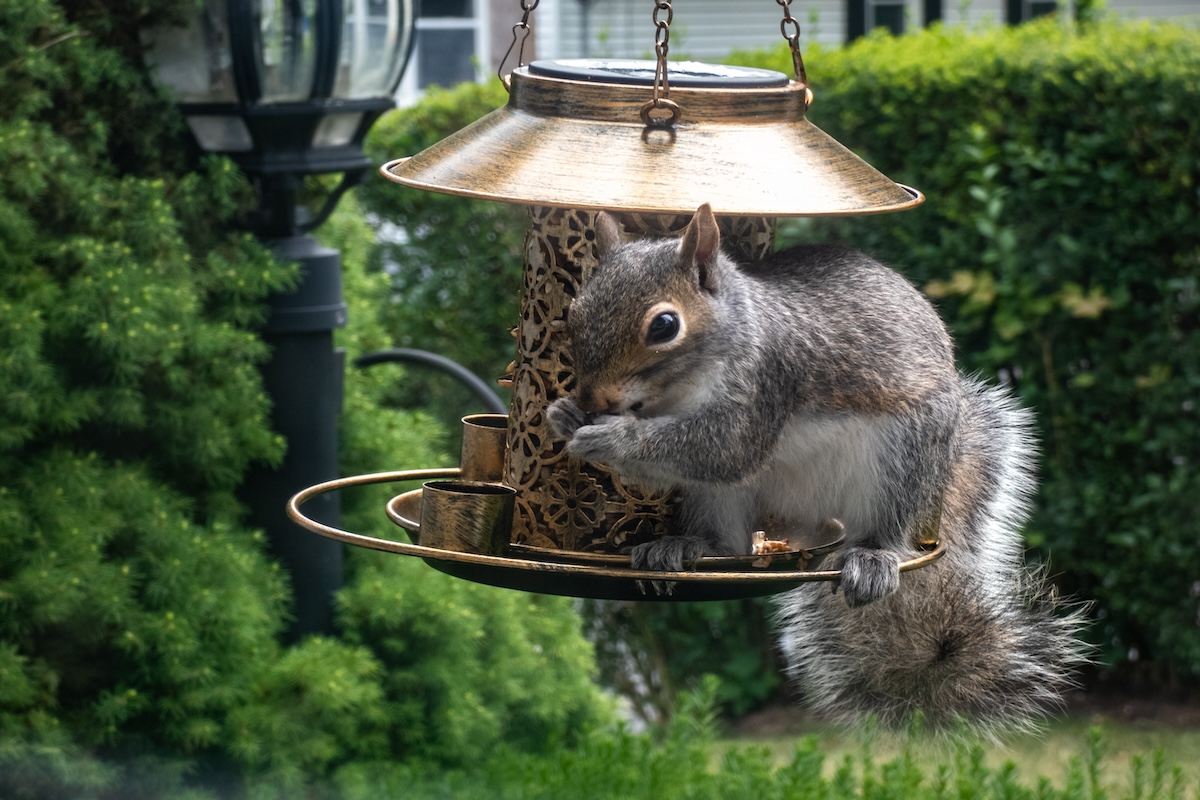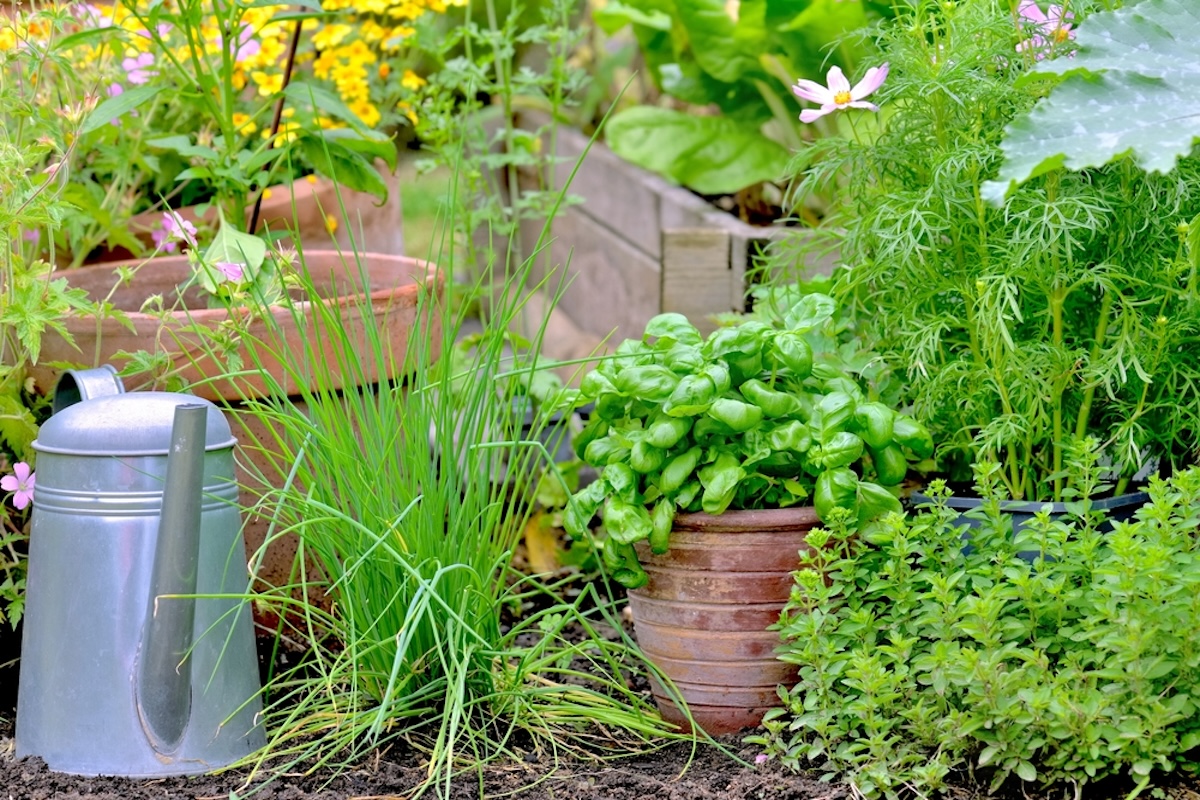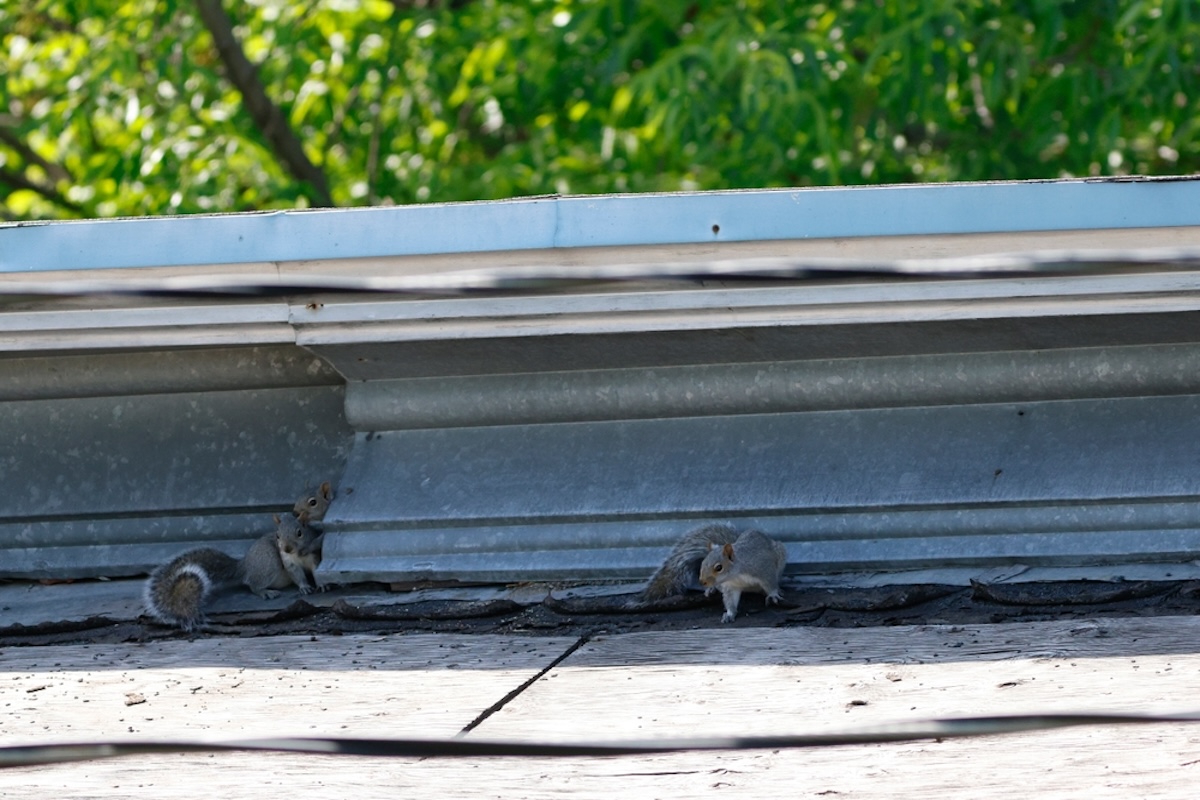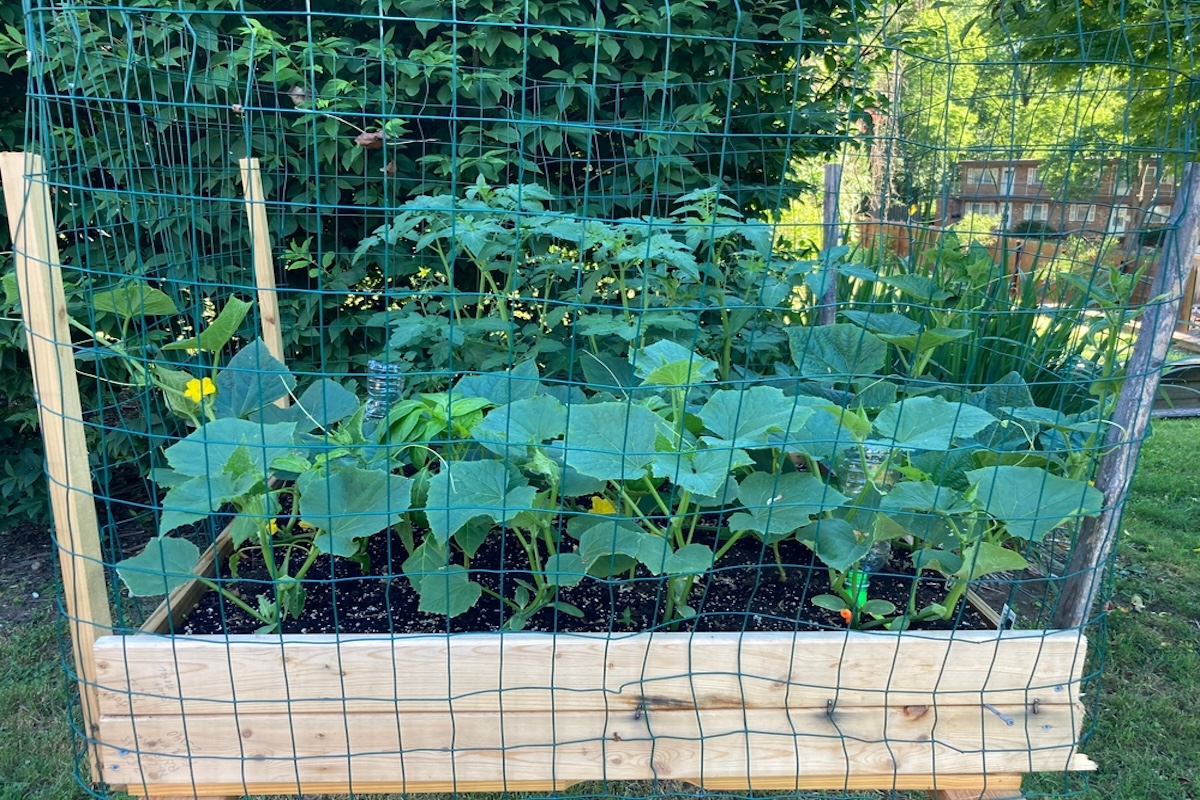

We may earn revenue from the products available on this page and participate in affiliate programs. Learn More ›
Squirrels are cute and bright-eyed, but they can do an impressive amount of damage to your garden and even to your home (particularly the attic and eaves). Depending on the type of squirrel you have, you might see dug-up bulbs in your flower beds, half-eaten tomatoes, or emptied or damaged bird feeders. Squirrels can even chew or gnaw on tree bark and through materials on your home like eaves and vents. If squirrels get into your home, they can damage insulation while building nests or chew through wiring in the attic.
When they become a nuisance or worse, you’ll want to know how to keep squirrels away from gardens or structures. According to Sean Neiswenter, Ph.D., associate professor at the University of Nevada Las Vegas School of Life Sciences, the fastest way to get rid of squirrels is to get a dog. “It really depends on the dog, though,” he admits from experience. Aside from dogs or wildlife predators, squirrels also hate strong scents and loud noises. You can try plenty of humane tactics to help shoo away these mischievous creatures.
Squirrel-proof your bird feeder.

Bird feeders attract squirrels, but you can take steps to make the feeders less attractive or accessible. The first step is modifying placement. Squirrels can jump vertically up to 5 feet high, 7 feet horizontally, and fall from up to 9 feet, says Neiswenter. So feeders or other attractions need to be high enough off the ground and far enough away from fences. Since trees offer plenty of options for climbing and jumping, try other tactics to make the food less attractive. For example, squirrels are less likely to eat safflower or nyjer seed, so switch to these if possible.
Moving feeders from trees to feeder poles makes it tougher for squirrels to access the seeds and nuts they like. Many poles have or can hold baffles like the Predator Guard 19-Inch Steel Baffle that you can place just above the feeder. Another option is to buy a squirrel-proof feeder like the More Birds X-1 Feeder. No matter whether you use a pole or squirrel-proof feeder, try to place the tempting food far away from any area of your garden or property squirrels might damage.
Make or purchase a baffle for tree trunks.
On trees, squirrel damage might show as chewed or stripped bark and missing or half-eaten fruit. If a tree has damage or is your best spot for a bird feeder, consider placing a larger baffle around the tree trunk. The cone-shaped wraps need to be at least 2 feet in diameter or slightly larger than your tree trunk circumference at about 5 to 6 feet off the ground. Ensure the tree’s branches are more than 7 feet from a fence or another tree, or squirrels will simply find another way to get into the tree.
Most commercial baffles are made of metal, but are meant to hang over bird feeders more than to wrap around a tree trunk. However, you can cut tube baffles out of metal ducting, metal flashing, or heavy plastic (such as a 5-gallon bucket with the bottom removed and a slit cut down one side). The key is a slick surface that makes it hard for squirrels to climb up the trunk. Be sure to place it about 5 feet from the ground and secure it carefully to avoid damaging the trunk.
Spray or set out aromatic squirrel repellents.
Squirrels tend to dislike strong aromas, and these make some of the best squirrel repellents. You can DIY sprays that they dislike by mixing water, a few drops of dish soap, and drops of one of the following into a spray bottle:
- Essential oil of peppermint
- Eucalyptus essential oil
- Citrus oil
- White vinegar
- Rosemary essential oil
- Pepper (white, black, or cayenne)
- Garlic essential oil
An alternative to sprays is to soak cotton balls in the same oils or scents and place them near or around plants, feeders, or other items to keep squirrels away. You also can lay out or rub strongly scented soap such as Irish Spring on a surface, sprinkle cinnamon, or put out coffee grounds. Neiswenter says easy DIY scents can work to deter squirrels, but cautions homeowners to remember that “most (scents) are limited in how long they last so you need to continue to reapply.” He also cautions that some scents can impact other wildlife you might welcome to your yard.
Sprinkle hot pepper.
Capsaicin, the active ingredient in hot peppers, is a good way to deter squirrels, according to Neiswenter. Sprinkle ground cayenne pepper around plants squirrels go after, or at the base of a tree. Capsaicin also comes in liquid form to add to a repellent spray. Mammals have a sensor that detects the hot spice, “and most mammals don’t like it,” Neiswenter says.
“Birds don’t have this particular receptor so they don’t experience the spiciness,” adds Neiswenter. He says you can buy seeds with capsaicin coating or “incorporate chili pepper seeds into your own bird mix” to deter squirrels from bird feeders.
Grow plants that deter squirrels.

When looking for a repellent for ground squirrels, look no further than some of your favorite shrubs. In addition to mint plants, Neiswenter says squirrels don’t like “edible plants that have strong smells.” Consider interplanting these plants that deter squirrels in your vegetable garden, or near bird feeders, fruit trees, or areas where squirrels tend to be a nuisance:
- Rosemary
- Onion (and ornamental alliums)
- Garlic
- Nasturtium
- Mustard
- Marigolds
- Hot pepper
Use predator animal urine.
Look for products with predator urine to repel squirrels. Examples include fox and coyote urine like Outdoor Hunting Lab’s coyote urine spray. Many of the sprays are available from hunting, gardening, or home improvement retailers. Just note that these sprays also can ward off rabbits or other small animals and the scent can be unpleasant for people.
Like essential oil sprays, these products can lose their effectiveness from rain or even lengthy sun exposure, and require regular reapplication. Alternatively, use small, repurposed containers to hold predator urine. You will need to poke holes in the lids to let the scent out and secure them with a rock or brick if they are light plastic. Space the urine containers about every 10 feet around the perimeter of the plants, feeders, or areas you would like to protect.
Scare them.
Scaring squirrels away with sounds, motion, or sprinklers can work for a time, but the animals might get used to your noise. If you have a dog that barks at or chases squirrels, you’ll get quicker and probably more lasting results. Here are some other ways for getting rid of squirrels by scaring them.
- Motion-activated repellents with ultrasonic sounds and lights get mixed reviews, but they might scare the critters away. And most, like the Broox ultrasonic animal repellent, are solar powered.
- Try spraying squirrels with a blast from your hose or invest in a motion-activated sprinkler like the Orbit 6200 Yard Enforcer.
- If you spot a squirrel where it shouldn’t be, step outside and clap or bang on a pan.
- Try pinwheels in beds with bulbs that squirrels like or hang old CDs or other shiny objects near feeders or gardens to deter them visually.
Protect plants and homes with physical barriers.
Making it tough or impossible for squirrels to get to food or gnawing and nesting spots requires a little vigilance. Keep a close eye for damage that appears to be from an animal, such as signs of chewed wood siding, nest building, or storage of food. Since squirrels can get through holes as small as a golf ball, it’s essential to look for and cover or close gaps they can use to enter your home or parts of your garden.
Make it difficult for squirrels to nest in walls, roofs, and attics.

When the weather turns cold, squirrels look for warmth indoors, where they can cause damage to wires or other materials and leave droppings, or even become trapped in an attic. Signs of squirrels indoors include rustling or scratching sounds, nests, or dark stains on openings or house siding where they might be squeezing through to enter. The animals can gnaw through spots like soffits, vents, and even wood, metal, or shingles. If a squirrel has entered your home, make sure it is out before attempting to seal its entry point, calling in a professional to remove the squirrel if necessary.
To prevent squirrels from damaging your home:
- Check for possible entry points such as openings in siding, the chimney, or roof eaves and shingles.
- Seal and repair holes or damaged wood or siding.
- Cover holes until you can repair them. Use metal flashing or ½-inch hardware cloth, which they find more difficult to chew through.
- Make sure your chimney has a tight-fitting cap.
- Trim trees so they do not give squirrels access to your roof.
- Selectively spray or sprinkle products, such as cayenne pepper or nontoxic squirrel repellent, that will deter chewing on vulnerable areas.
Use barriers to keep squirrels out of gardens.

Squirrels can eat or gather almost anything, from insects to berries and fruit. If you see half-eaten tomatoes, destroyed foliage, signs of digging, or similar damage in your garden, you might have a squirrel problem. These physical barriers and annoyances might help you get rid of squirrels in your garden:
- Shield ground crops by adding a row cover or enclosing tempting plants with chicken wire bent into cages and topped with more chicken wire or bird netting.
- Cover beds that contain freshly planted bulbs or tender seedlings with chicken wire.
- Build a fence from hardware cloth and T-posts around your vegetable garden, fruiting trees, or young saplings, burying the metal a few inches into the ground to deter digging under the fence (even deeper if you also have to deter groundhogs).
- Lay mulch such as gravel in paths or beds since squirrels might not like the rough feel of the mulch on their feet.
- Place bird netting over fruit trees or shrubs to prevent squirrels from easily reaching the fruit, but check it often, since they can chew through cloth.
Final Thoughts
According to Neiswenter, squirrels are entertaining, and maybe your best bet is to learn to live with and enjoy them. To do so, he suggests giving squirrels their own feeder like this TreeGun Squirrel Feeder, which also can distract chipmunks, to lure the critters away from your garden or bird feeder. Fill it with foods they like such as cracked corn, peanuts, or sunflower seeds. Neiswenter recommends nuts still in their shells so the squirrel “will have to spend more time getting the nut out of the shell,” which will keep it busy and might provide some entertainment.
“Dried corn on the cob is also really fun to watch if you attach it to something so they can’t run away with the whole thing,” he says. Neiswenter once built a squirrel see-saw with corn cobs on each end. He says you can even search for plans for squirrel mazes if you want to keep them busy. Combine this approach with repellents or barriers around feeders, plants, or structures and place the squirrel area in a separate part of your yard.
FAQ
The fastest way to chase squirrels away is by letting your dogs—if they’re so inclined— scare them away. You can also spray predator urine to remind them that your yard might not be the safest spot to dig and dine. However, most squirrel deterrents take time and a combination of approaches. Your other option is to remove or protect the foods and structures that attract them. Placing hot pepper flakes in your bird feeder or using baffles to keep them from reaching feeders are among the quickest methods for keeping squirrels out of bird feeders.
“The 5-7-9 ‘rule’ refers to a general guideline of how far squirrels can jump vertically, horizontally, and fall,” says Neiswenter. Keep this in mind when placing bird feeders or protecting your home so that the distances between tree branches and your roof or bird-feeding tree are far enough. In general, hang feeders or set baffles at least 5 feet high, 7 feet horizontally from a bush or tree, and 9 feet of falling height (such as from a branch above to your roof or bird feeder below). He adds, however, that this depends on the type of squirrel, and that “flying squirrels can glide more than 100 feet.”
“My personal feeling toward noxious or toxic chemicals is that I don’t want them in my yard or around my kids and pets,” says Neiswenter. He adds that chemical repellents can affect other wildlife that you might want in your yard. It’s best to try a combination of natural pest control methods such as scents and physical barriers rather than chemicals. “I would consider these as a last resort, if at all,” he says.
Although trapping and relocating squirrels can work in rare cases, it’s not the kindest or most effective method to get rid of squirrels. Neiswenter mentions several reasons not to turn to trap-and-relocate strategies:
-“First and foremost, if there’s one squirrel, there are probably a bunch of squirrels,” he says.
-The animals have impressive homing abilities, and are likely to return if relocated within a
little more than a mile.
-Relocating an animal can reduce its survival, mostly because the squirrel is not familiar with
its new environment, so “some might consider it more humane than euthanizing the animal, but
it’s not without its downsides,” says Neiswenter.
-States have various laws regarding trapping, handling, and translocating animals, says
Neiswenter, so you should always check with authorities or hire pros.
